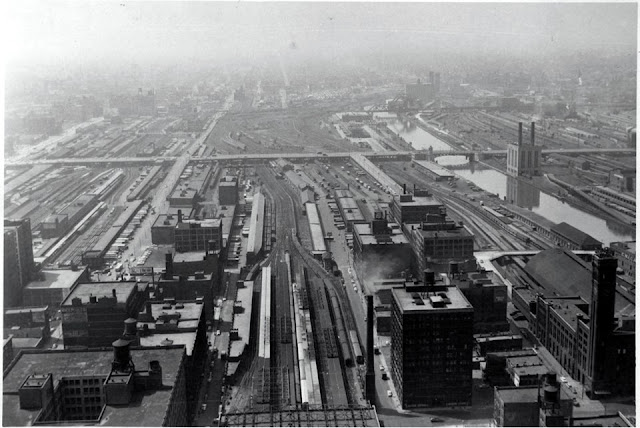On page 6 of the main section of the October 24, 2014, Chicago Tribune had an article by Richard Wronski announcing the completion of the CREATE project P1. So it is time to research that project.
Once again, the CREATE web site has not been updated to record the cost nor the completion date. So I'm really glad I tripped across the page 6 article. The cost was $142 million. This project is easy to understand -- the former Rock Island tracks (now Metra) are raised over the former Pennsylvania (now NS) tracks at what was the Englewood Junction. Amtrak also uses the NS tracks. Update: a video of the dedication ceremony has some interesting background activity.
 |
| Kevin Piper posted Robert Petit: I believe that this is a Mark Llanuza photo for Metra on the dedication of the flyover. Marshall Beecher: I, too had the pleasure of being here to get these shots, but non disclosure agreements prevented any of mine from seeing the light of day back then. It was truly a rare thing with the Rock both above and below the NS Chicago line, at the time. Sayre Kos: Marshall Beecher You may recall the Amtrak movement was a bonus: That was the annual AAPRCO special headed east. Here’s one above and one below: |
 |
| Chicago Tribune, Oct. 24, 2014 |
 |
| Satellite before construction |
At first the cost surprised me because I remembered that the B2 project cost "just" $83 million. But then I identified some reasons why P1 would cost more:
- The bridge+approaches can carry 3 tracks instead of one.
- Since the project description indicates the scope of work extends to 69th Street, it appears the southern approach needed to go over I-90/94. This is a lot bigger span than the NS tracks.
- The bridge is "double high" since it is going over tracks that are already elevated.
- Since the new construction is west of the existing tracks, some urban property may have been purchased.
A construction video confuses me. Since the span behind the crane crosses the NS tracks, what is the purpose of the span for which it is lifting girders? That seems to be an rather expensive span over dirt. I need to give some more thought as to whether or not I'm going to go to that neighborhood to take my own pictures.
The Tribune article also explained the controversy concerning the usage of minority-owned contractors. I believe it is a fair summary that the Metra CEO, Alex Clifford, thought he was being asked by the Metra chairman, Larry Huggins, to bribe the over site hiring monitor -- the National Black Chamber of Commerce -- with $50,000. Also Clifford thought that a $200,000 no-bid contract that Huggins helped Target Group get did not fullfill the terms of the contract. These were some of the issues that caused Clifford to leave Metra in May 2013. If you Goggle "metra scandal" you are offered several to choose from. I saw that soon after Clifford left, 6 board members were gone. I was looking for a reminder of which disgraced Metra executive committed suicide by stepping in front of a Metra train, but I could not find that information.
 |
| Todd Hollritt posted |
Norfolk Southern 20K the 63rd Street – Chicago, IL to Croxton Yard – Jersey City, NJ intermodal freight arrives at the former Erie Lackawanna.Calling it 63rd Street cost me some time. There is nothing at 63rd Street. Even after the planned extension, the yard goes to just 59th Street. I believe the train is going to the intermodal yard that combined the former Wabash and C&WI/Erie yards.The train is still several blocks away from the yard.
An aerial photo by the Tribune showing the flyover and a NS train crossing the expressway. Also some of an NS intermodal yard on the right side of the picture.




































.jpg)








